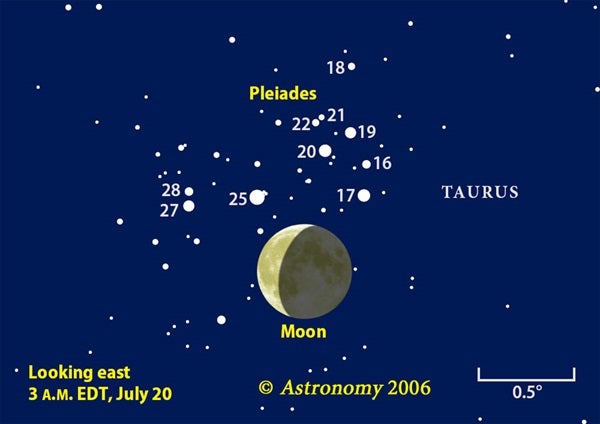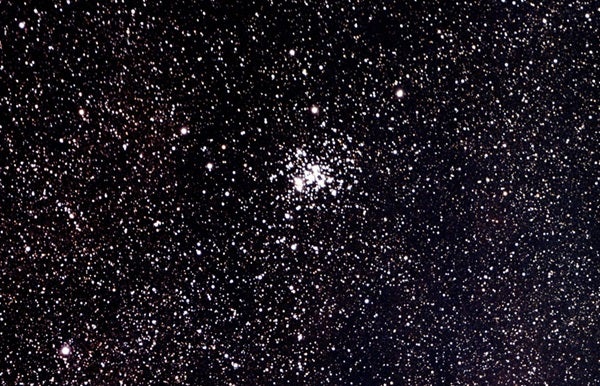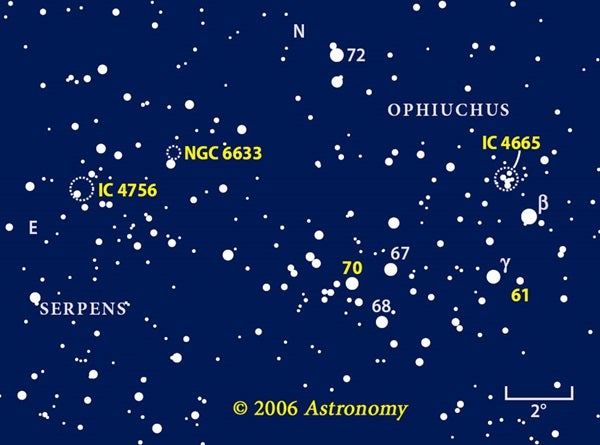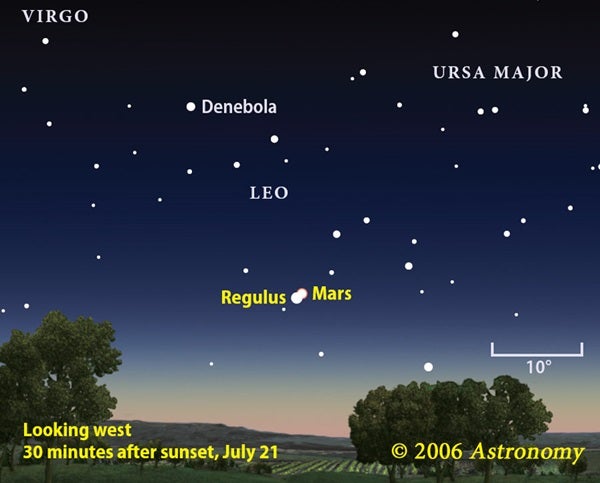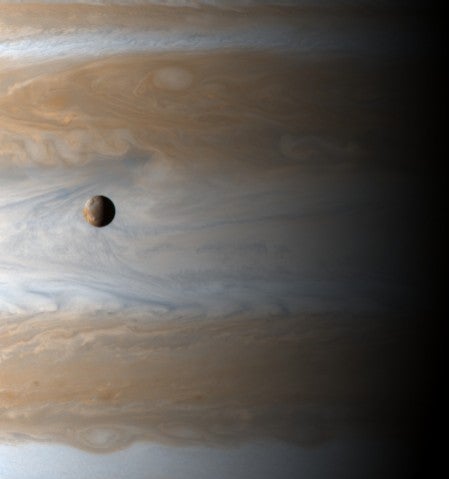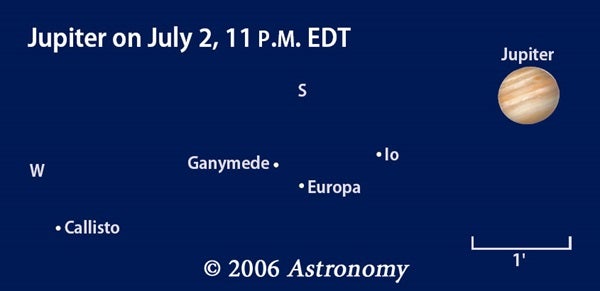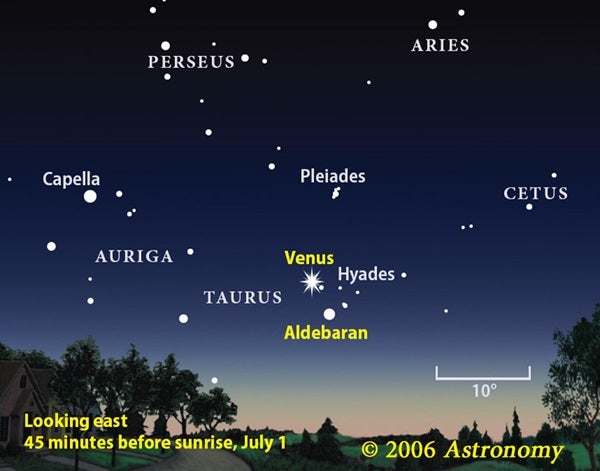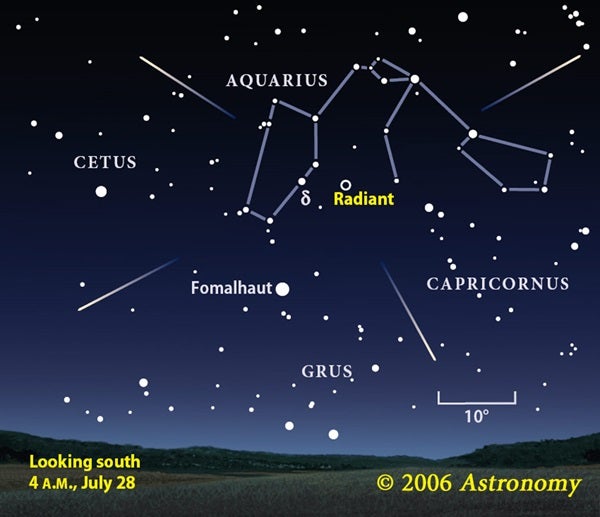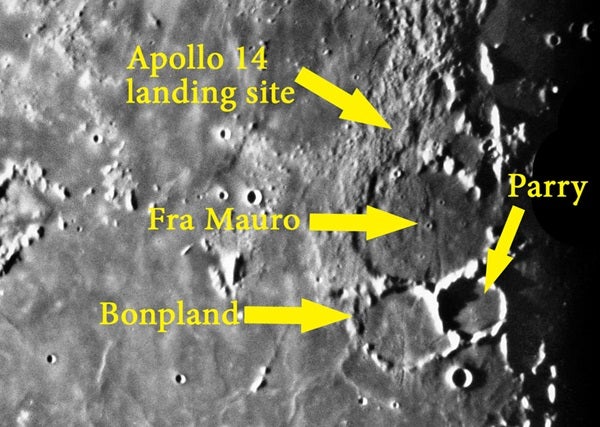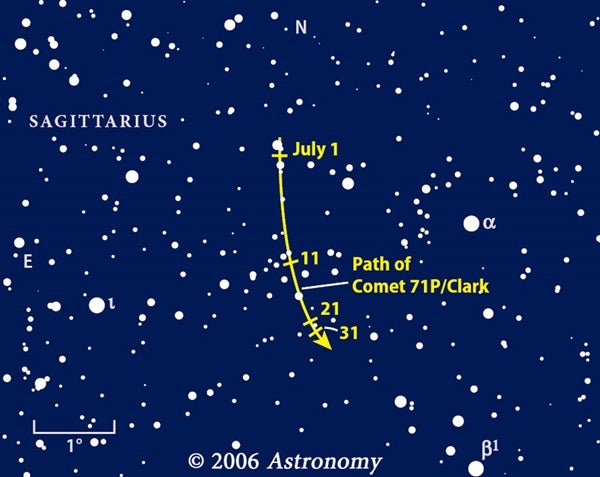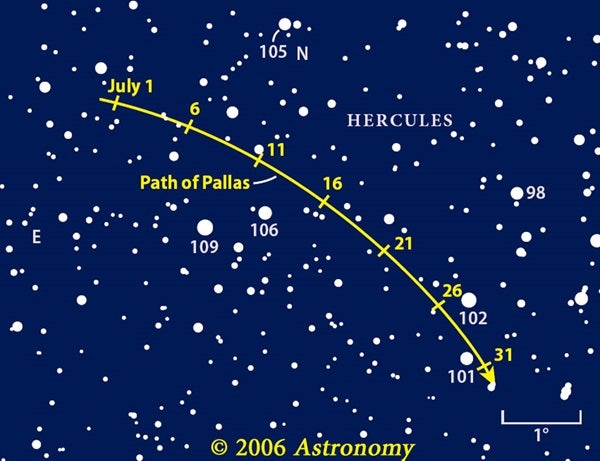You can start observing Jupiter as soon as it becomes visible in evening twilight. The late-day atmosphere typically is well-mixed, which reduces the rippling waves that interfere with clear views. Don’t be put off by haze or light pollution — they have little effect on the planets. Patience will be your biggest ally. The more time you spend at the eyepiece gazing intently at Jupiter’s cloud tops, the more detail you’ll see.
What starts off as two straight bands crossing a uniform disk resolves into multiple lines with ruffled edges, white spots, dark “barges,” and wispy festoons, dark features that jut into Jupiter’s bright Equatorial Zone. Sometimes, you can catch the Great Red Spot. Its 2-decade-long pallor has made seeing it a challenge compared with the brick-red hue it exhibited at the start of the Space Age.
Earth’s North Pole points away from this part of space, so the planets and Moon scoot low across the southern sky these July nights. On the positive side, this makes the Sun climb high and gives us the longer, hotter days of summer. Viewed from the Southern Hemisphere, Jupiter passes nearly overhead — 6 years of great observing has started.
Mars and Saturn remain visible in the west-northwest an hour after sunset in early July, but twilight does a good job of masking them. Binoculars make them easy to spot. The only bright star nearby that might confuse you is Regulus. This star lies to the planets’ upper left, and its blue-white color should give it away. Keep an eye on Regulus as it sinks deeper into the twilight during the next few weeks. It skims below Mars July 22, leaving a gap large enough for the Moon to pass through.
When Saturn returns to the evening sky next winter, it will be in close company with Regulus. The planet’s rings will look much flatter then, as they approach their edge-on appearance in 2009.
The Moon’s orbit carries our satellite much farther from the celestial equator than usual this year, forcing Luna to cut abnormally low across the southern sky during its evening parade. On the night of July 5, it passes south of Jupiter by 5°, nearly a full binocular field of view.
The low elevation means the Moon’s light has to travel a longer path through our atmosphere. Compared with the stark white Moons of winter, summer Moons are painted with a warmer, pale-yellow hue.
If there’s one event worth setting your alarm for, it’s a passage of the crescent Moon through the Pleiades star cluster. On the morning of July 20, observers in the eastern half of North America should have a great view. Binoculars will show a spectacular vista, with the Moon’s dark face filled with gray earthshine. Through a telescope, you can watch the bright limb snuff out stars in the blink of an eye. Thirty to 60 minutes later, they pop back into view from behind the dark limb.
When the Moon returns to the evening sky July 27, it will be a lovely crescent lined up with Mars and Regulus. The Moon actually covers up Mars as seen from Europe, but this event occurs during daylight and won’t be impressive.
Clusters for bright nights
For many backyard observers, summer is not welcomed with open arms — the sky just doesn’t get totally dark during the brief night. Latitudes north of 50° suffer from perpetual twilight — the Sun performs a shallow slide under the northern horizon before rising all too soon in the northeast. An equally challenging problem faces big-city dwellers who don’t have the means to get to dark sites.
Perhaps the easiest non-Messier cluster for northern observers to find is NGC 6910. It lies less than 1° north of Gamma (γ) Cygni, the central star of the Northern Cross. Simply aim your scope at Gamma, and then shift toward Polaris by half a field of view. This splashy group contains two lovely yellow-orange luminaries surrounded by a dash of white followers.
A stunning cluster lurks near the horizon for those at mid-northern latitudes. NGC 6231 in Scorpius lies slightly north of Zeta (ζ) Scorpii. It consists of more than a dozen 6th- and 7th-magnitude white stars crammed together with scores of more modest companions. Even if NGC 6231 skims only a few degrees above your southern horizon, it will impress you.
Regardless of where you live, the sky near the celestial equator delivers glittering clusters that climb well above the horizon. Three favorites lie along the northern branch of a Milky Way spiral arm in eastern Ophiuchus. Aim your binoculars at Beta (β) Ophiuchi, and you’ll see several bright stars topped off by a large, bright cluster.
A bit harder to spy from the city is the double gem of NGC 6633 and IC 4756. To find this pair, slide left 2 binocular fields from IC 4665. NGC 6633 appears brighter and more compact than IC 4756, which looks like a detached piece of the Milky Way. Any small telescope will show you the difference between these two star clusters. One appears bright and splashy with plenty of pairs; the other looks like a mound of stardust with added sparkles.
Take a close look at 61 and 70 Ophiuchi through a telescope. The former is an easy double star separated by 21″ — half of Jupiter’s apparent size. When you factor in its distance of nearly 500 light-years, this translates to a separation of 80 times the distance between the Sun and Pluto. A tighter pair, 70 Ophiuchi is best known for its color controversy. Observers have reported everything from “gold and violet” to “colorless.”
The brightest of the three is Saturn, shining at magnitude 0.4. Spot it low in the west about 40 minutes after sunset. Saturn currently lies in Cancer the Crab, whose dim stars are lost in the twilight. The planet dips below the horizon by 10:30 P.M. local daylight time July 1 and a few minutes earlier each night thereafter. By July’s close, it’s gone from view, devoured by the Sun’s brilliant glow. By August, Earth’s motion will carry Saturn to the far side of the Sun.
Mercury briefly shares the same area as Saturn. On July 1, it lies 9° to Saturn’s lower right. The innermost planet appears noticeably fainter, however, and fades each consecutive night. You’ll find it nearly impossible to pick up in the bright twilight and low-altitude haze after the 1st unless you observe through crystal-clear air and can see down to the horizon. Mercury passes between the Sun and Earth July 18, a configuration known as inferior conjunction. It will reappear in the morning sky in late July.
Mars wouldn’t be worth a second thought if not for its close conjunction with the bright star Regulus July 21/22. From July 1 to 20, Mars crosses the 13° separating it from Regulus. By the 21st, the planet stands a mere 41′ to the upper right of Regulus. Binocular and low-power-telescopic views of the pair will reveal a memorable color difference. Mars, with its reddish hue, contrasts beautifully with the blue-white star. One night later, Mars has moved noticeably relative to Regulus and then stands 44′ almost directly above the star.
Like Saturn, Mars currently lies on the far side of the Sun from Earth. The Red Planet’s tiny globe appears only 4″ across, too small to show any features. Mark your calendars for July 27, when the 8-percent-illuminated crescent Moon joins Mars and Regulus low in the western sky. Each object lies less than 4° from its neighbor, creating a scenic highlight for sky photographers.
Jupiter resumes its eastward motion against the background stars this month. Each night, it stands slightly closer to Alpha (α) Librae, also known as Zubenelgenubi, and ends July 5° shy of this 2.6-magnitude star. Any telescope will deliver a fine view of Jupiter’s disk, which spans 39″ in mid-July. The alternating dark belts and bright zones in Jupiter’s atmosphere change their appearance in subtle ways from night to night. Tracing these changes can be one of the more enjoyable aspects of observing with a small telescope.
Warm evenings also make the giant planet a fine target for casual viewing. Show it off to your friends and neighbors. They may never have seen a planet through a telescope — particularly one as impressive as Jupiter. The sight will let them experience the same thrill of discovery Galileo had 400 years ago, when he saw, for the first time, four tiny moons orbiting the giant planet.
Io, Europa, Ganymede, and Callisto wander back and forth in the plane of Jupiter’s equator. Because they revolve in different periods, this produces a fascinating mix of patterns. Io, for example, takes less than 2 days to complete one orbit. You can see its motion over the course of 1 evening. Callisto, the outermost major moon, takes nearly 17 days to finish one orbit and remains roughly in the same position during a single night.
Although finding the right field of view is easy, actually seeing Pluto is not. Pluto reached opposition in June and remains at its brightest: magnitude 13.9. Visually sighting an object this faint is a challenge for anyone with a scope smaller than 10 inches in aperture. The planet’s visibility depends on many factors, such as local light pollution, the transparency of Earth’s atmosphere, and the acuity of your eyes.
Pluto’s neighbor, Neptune, remains in Capricornus the Sea Goat this month. Neptune glows dimly at magnitude 7.8, which makes it a good target for binoculars or a small telescope. You can find it 1.8° north-northeast of Iota (ι) Capricorni, where it stays visible all night. On July 10, Neptune appears to be double. This illusion comes about as it passes 2′ south of an 8th-magnitude star. Neptune’s motion relative to the star will be obvious over 2 consecutive nights.
Uranus is easy to spot in binoculars and, at magnitude 5.8, can be glimpsed with the naked eye under a dark sky. This month, it lies in Aquarius the Water-bearer near the stars 82 and 83 Aquarii (magnitudes 6.2 and 5.4, respectively). Uranus passes between these two July 24 on its way toward 6.2-magnitude 81 Aquarii. Uranus and the stellar trio lie 3° east of Lambda (λ) Aquarii and appear reasonably high in the sky from local midnight through the early morning hours.
By July’s close, Mercury re-emerges in the morning sky. As it rises out of the brightening morning twilight, it stands 7° directly below Venus. Mercury pales in comparison to Venus, but will grow brighter and more prominent during the first week of August.
Viewing the southern branch of the Delta Aquarid meteor shower benefits this year from the Moon’s absence.
This annual shower’s activity stretches from July 12 to August 19, so it significantly overlaps next month’s Perseid meteor shower. The southern Delta Aquarids should peak July 28, just 3 days after New Moon.
At its peak, this shower produces a zenithal hourly rate — the number of meteors that would be seen per hour under a pitch-black sky if the radiant were overhead — between 15 and 20. From North America and Europe, however, the radiant never climbs this high, so observers typically see about half as many meteors. The radiant reaches its greatest elevation between 3 and 4 A.M. local daylight time.
A second stream of Delta Aquarids, the northern branch, also is active in late July and much of August. It peaks at the end of August’s first week, so moonlight interferes with it significantly.
On February 5, 1971, the Apollo 14 lunar module — Antares — touched down in the Fra Mauro region. This site was originally the target for the Apollo 13 flight. That mission was aborted after an oxygen tank on the service module blew up. You can see the Fra Mauro region through a backyard telescope, although the Antares lander itself is far too small to glimpse from Earth.
Named after a 15th-century Italian monk and mapmaker, Fra Mauro Crater lies slightly west and just south of the center of the Moon’s disk. Apollo 14 landed just a couple of dozen miles north of the crater’s rim. Planetary scientists think this hilly region contains ejecta blasted out from the massive impact that created Mare Imbrium early in the Moon’s history. Numerous impacts since the mare’s formation have stirred up the surface, burying the original ejecta blanket.
Fra Mauro is an ancient and worn crater that measures about 60 miles across. Its battered walls are almost buried on the western side, and subsequent impacts have completely obliterated part of the eastern wall. You can find Fra Mauro northeast of Mare Cognitum and southeast of Mare Insularum, both of which lie due south of the prominent crater Copernicus.
Two smaller craters, Bonpland and Parry, lie along Fra Mauro’s southern rim. The Sun rises over this region July 4. Under low Sun angles, shortly after sunrise, a rille bisecting the larger of these two craters (Bonpland) shows up nicely. A set of aligned hills crisscrosses the region north of Fra Mauro. These hills point in the direction of the Mare Imbrium impact zone.
To be bright, a comet needs to be close to both the Sun and Earth. Neither condition applies to 71P/Clark. The nearest it gets to the Sun is the orbit of Mars, where the weak sunlight can’t liberate much dust from the comet’s nucleus. A comet’s brightness principally comes from sunlight reflecting off its dust shroud. Carried outward by solar radiation pressure, the dust can form a tail that streams for millions of miles.
A second tail, made of ionized gas, often gives comets their blue-green sheen. The gas comes from the comet’s nucleus, where ice turns directly to gas as the Sun heats the surface. Sunlight then ionizes the gas, and the solar wind carries it away from the Sun. But because Comet Clark lies far out, the only thing we’ll likely see is a diffuse fuzzball glowing at 11th or 12th magnitude, fainter than any Messier object.
To get a good view of the comet, get away from city skyglow and sidestep the light of the Moon. During the first week of July, wait until midnight for the Moon to set. After the 22nd, the waning crescent Moon will no longer be a problem. The comet tracks through southern Sagittarius this month, near the 4th-magnitude stars Alpha (α) and Beta (β) Sagittarii. If you live north of 50° latitude, you’re out of luck — 71P/Clark remains below your southern horizon.
New Zealand astronomer Michael Clark discovered this comet in June 1973. It orbits the Sun once every 5.5 years, which means every second return is lost in the Sun’s glare.
Some kind of accident must have befallen asteroid 2 Pallas during the solar system’s early days. As a general rule, the bigger pieces of rocky rubble that orbit the Sun between Mars and Jupiter cling close to the ecliptic, the plane where the planets travel. Pallas’ orbit, however, inclines a whopping 35° from its brethren. It likely suffered a big collision long ago that modified a more typical orbit.
German astronomer Heinrich Olbers discovered Pallas in 1802 while looking for the first asteroid, Ceres. Olbers — best known for posing Olbers’ paradox: Why is the sky dark at night? — also discovered the brightest asteroid (Vesta) and several comets. Pallas turned out to be a bit more than 300 miles in diameter, making it the second-largest object in the asteroid belt between the orbits of Mars and Jupiter. Its slight motion from one night to the next betrayed its identity.
This same technique will be your best strategy for finding Pallas, which reaches opposition July 1 and remains visible all night. The asteroid takes about 4 days to drift across a typical telescope’s low-power field of view. Center your scope on its predicted position in southeastern Hercules, and then make a quick sketch of the six or seven brightest stars. Your sketch will include Pallas, glowing at magnitude 9.5. Come back a night or 2 later to see which dot has moved.

